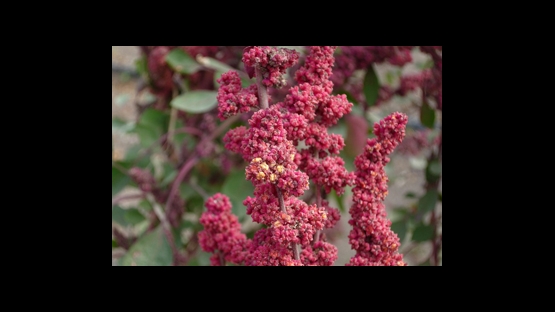Hunger continues to be a reality for mankind; in global terms, it is estimated that over 842 million people or around one in eight people in the world face starvation due to extreme poverty while up to 2 billion people, due to varying levels of poverty, lack food security. The eradication of hunger is of paramount international concern. Linked to this is agricultural production, especially in developing countries, which faces a challenge in keeping pace with rising food requirements. In the battle to help agro-economies of developing countries to overcome threats from declining or stagnant food production, one species of a grain-like crop, grown primarily for its edible seeds, is quinoa, which has caught international attention.
Quinoa is a pseudo-cereal rather than a true cereal, or grain. It has been grown since ancient times in the Andean civilization in Latin America, becoming the staple food of the Andean peoples. Quinoa is now considered by nutritional experts to have the ability to play a critical role in overcoming the complex and inter-related issues of hunger, malnutrition and poverty. Due to its high nutritional value and with its increased production, quinoa is set to be a major food for future generations.
Quinoa, also known botanically as Chenopodium quinoa, is one of the basic dietary foods of the Andean peoples, roasted and ground into flour to make a range of foods. Quinoa products are also found mixed with cereals, and are used to prepare bread and pasta as well as gourmet foods. Its nutritional composition is extraordinary, considering it's a source of complete protein in-take, having more protein content than brown rice, barley and millet. Besides being gluten free, quinoa is an excellent source of dietary fibre and has elevated levels of phosphorus, magnesium, iron and calcium. The crop is also vitamin rich.
In the early 1970s, quinoa faced the threat of being destroyed due to the spread of plant diseases. Adverse climate conditions also affected the income of farmers resulting in a decline in its traditional cultivation methods. The low yield of quinoa has also led to an increased world wide price hike due to rising demands. Increasing its production, to fulfil the global demand is vital for all levels of society especially the poor sections of society and those vulnerable to malnutrition.
These concerns have led to a concerted and now successful international effort to protect this valuable crop from disappearing. In this global effort, the IAEA in its joint collaboration with the FAO has used highly advanced nuclear techniques to support technology transfer and adaptation, and to build capacity through coordination research projects and regional technical cooperation programmes aimed at increasing quinoa production in developing countries.
To improve agricultural production, the IAEA is promoting the application of nuclear techniques for plant breeding. Often, it is not easy for breeders to find useful variation needed for their purpose. Mutagenic agents, such as radiation and certain chemicals, can be used to induce mutations and generate genetic variations from which desired mutants may be selected. Mutation induction is a clean, tested and robust technique to create variation and produce new crop varieties.
In particular, the IAEA through its Joint FAO/IAEA Programme has been successful to assist the Member States to develop new mutant varieties that can grow in challenging environments. Mutation induction based on irradiation is a tool to broaden the adaptability of food crops to dynamic agro-ecologies and to improve resource use efficiency by fostering the application of mutant varieties for local crop production in developing Member States, thus contributing to sustainable food security and biodiversity of nature world.
For instance, in Peru, "There are 64 mutant lines of quinoa selected by their yield potential and quality for the market. From these lines, 3 will be further developed and released to farmers as new varieties in 2014," said L. Gomez-Pando, from the National Agrarian University of La Molina.
Quinoa is cultivated locally in the Andean region, from Colombia to Argentina in the north, to Chile in the south. It is planted mainly at elevations of 3 000 meters (up to 4 000 meters), where hostile climatic conditions thwart the growth of other crops. The key producing nations are Bolivia, Peru and the United States. Other countries in the developed world involved in quinoa cultivation are France, England, Sweden, Denmark, Holland and Italy. In Africa, Kenya has been involved in quinoa farming, showing high yields while further up towards India, the Himalayan regions have also witnessed success in its production.
The recognition of the value of quinoa has led to a greater global demand to protect this rare grain and has transformed this crop from being neglected as a food crop to one of high international demand for its nutritional value. Quinoa is also tolerant to salt, drought and frost and these attributes have enabled a wider global interest in its continued cultivation. The unique nutritive balance of protein, oil, fat and starch is also found in quinoa.
The FAO/IAEA collaboration to facilitate and promote the development of new and high yielding quinoa varieties will allow farmers to improve their income levels as well as have adequate quantities of protein as part of their daily diet and provide grains with affordable prices to persons with malnutrition problems, especially children below five years of age.
In recognition of ancestral practices of the Andean people, who have through centuries preserved quinoa in its natural state as food for today and for the generations to come, the United Nations General Assembly has declared 2013 as the International Year of Quinoa. The IAEA has played an important role in helping the international efforts to collect and preserve the genetic resource at National Agrarian University of La Molina - Peru and to start the genetic improvement of one of the rarest of rare agricultural crops which has survived because of the traditional practices of living in harmony with nature.


